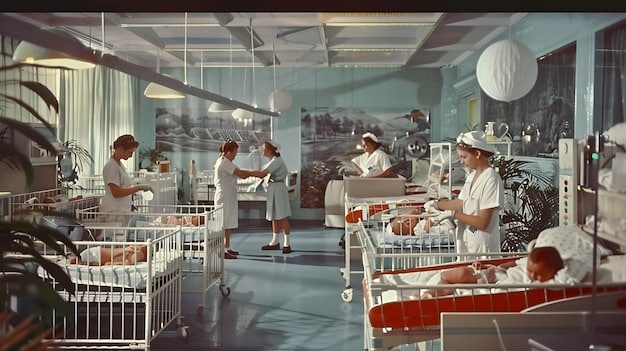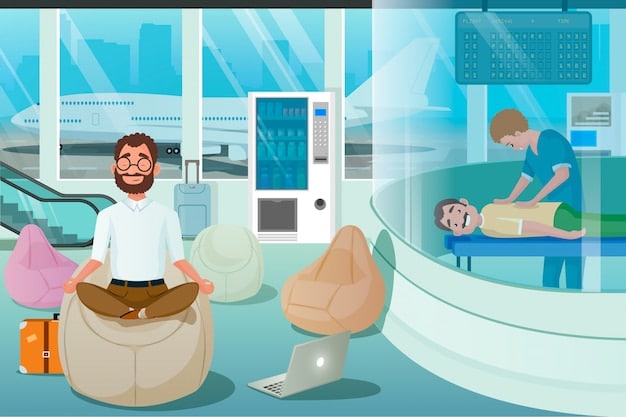Emergency Room Triage: Separating Drama from Reality in Medical TV Shows

Emergency room triage, as depicted in medical dramas, often exaggerates the speed and intensity of decision-making, prioritizing dramatic effect over clinical accuracy, leading to a distorted perception of actual medical protocols and resource allocation.
How accurately do medical dramas depict the high-stakes world of emergency room triage? Let’s dive into a 2025 analysis to separate fact from fiction in the portrayal of ER triage on your favorite medical TV shows.
Emergency Room Triage: The Real Deal vs. The Reel Deal
Emergency room triage is often the first point of contact for patients seeking urgent medical care. But how close are the dramatized versions we see on TV to the actual procedures and protocols followed in real-life emergency rooms?
Medical dramas thrive on creating intense, gripping narratives, frequently prioritizing entertainment over absolute accuracy. This can lead to significant deviations in how emergency room triage is portrayed compared to its real-world counterpart.

The Core Principles of Real-Life ER Triage
In a real-life emergency room, triage is a systematic process designed to efficiently allocate resources and prioritize patients based on the severity of their condition. Several key principles guide this process:
- Initial Assessment: A quick evaluation to determine the patient’s chief complaint and vital signs.
- Categorization: Assigning patients to acuity levels based on established triage scales (e.g., Emergency Severity Index – ESI).
- Resource Allocation: Directing patients to the appropriate area of the ER and initiating necessary tests and treatments.
Common Misconceptions in Medical Dramas
Medical dramas, while entertaining, often perpetuate misconceptions about the complexities and nuances of emergency room triage. These misconceptions can range from exaggerated timelines to unrealistic decision-making scenarios.
For example, decisions may be made faster and in a compressed time, but here are typical things that are usually misportrayed:
- Instant Diagnoses: Medical dramas often portray doctors making immediate diagnoses based on limited information.
- Overdramatized Scenarios: Triage situations are frequently embellished with overly dramatic or rare medical events.
- Emotional Decision-Making: Personal biases and emotional considerations, while present in real life, are often amplified for dramatic effect.
In summary, there is a lack of accuracy in medical dramas when showing ER scenarios. The dramatic tension gets heightened, causing a lot of unrealistic characteristics.
Triage Systems: Accuracy vs. Drama
Triage systems are the backbone of emergency room operations, providing a structured approach to patient prioritization. However, the way these systems are depicted in medical dramas often diverges from reality.
The depiction of such systems is an essential part of portraying the emergency room experience and making the audience aware of the steps taken within the hospital to save a patient.
The Emergency Severity Index (ESI) in Reality
The Emergency Severity Index (ESI) is a widely used triage tool that categorizes patients into five levels of acuity, ranging from critical (ESI-1) to non-urgent (ESI-5). This system is designed to ensure that patients with the most life-threatening conditions receive immediate attention.
The levels include:
- Requires immediate life-saving intervention
- High risk situation
- Needs two or more resources (e.g., labs, x-rays)
- Needs one resource
- Non-urgent medical care needs
How Dramas Skew the ESI System
Medical dramas frequently compress the timeline of triage assessments, showing patients being rapidly moved through the system without proper evaluation. This can misrepresent the thoroughness and accuracy of real-world triage protocols.
Dramas sometimes prioritize excitement, causing a distortion in the triage system. Examples include:
- Ignoring Standard Protocols: Characters may bypass established triage protocols for the sake of expediency or dramatic effect.
- Misrepresenting Acuity Levels: Patients with minor complaints are sometimes portrayed as high-acuity cases to create tension.
- Focusing on Rare Cases: Dramas often highlight rare and unusual medical conditions, overshadowing the more common ailments seen in everyday ERs.
Through this process, we can see the differences between the reality and what dramas usually display in movies and shows surrounding ER triage.
The Role of Technology in Triage: Real vs. Reel
Technology plays an increasing role in modern emergency room triage, aiding in rapid assessment, diagnostics, and resource management. However, medical dramas often underutilize or misrepresent these technological advancements.
Technology contributes to the ability of medical staff to adequately conduct an adequate medical triage. It is important to portray it accurately.

Technological Tools Used in Real ERs
Modern emergency rooms rely on a variety of technological tools to enhance triage efficiency and accuracy. These include:
- Electronic Health Records (EHRs): Providing quick access to patient history and medical information.
- Point-of-Care Testing: Enabling rapid diagnostic tests at the triage station.
- Patient Tracking Systems: Monitoring patient movement and status throughout the ER.
Technological Misuse in Dramas
Medical dramas often depict technology as a plot device rather than an integral part of the triage process. This can lead to unrealistic or inaccurate portrayals of its effectiveness.
Some common examples of the misuse of technology include:
- Ignoring EHRs: Characters frequently make decisions without consulting available patient records.
- Overreliance on Advanced Imaging: Dramas often jump straight to advanced imaging techniques (e.g., CT scans, MRIs) without conducting basic assessments.
In medical scenarios, the technology in real life plays a huge role in the efficiency and operations of ER rooms, compared to what is portrayed in cinemas.
Human Factors in Triage: Where Dramas Get It Right (and Wrong)
While medical dramas often exaggerate the clinical aspects of emergency room triage, they sometimes capture the human elements quite effectively. The emotional toll on healthcare providers, ethical dilemmas, and interpersonal dynamics are often portrayed with surprising accuracy.
The human aspect can be very accurate in most movies. It all comes down to how the movie is portrayed, and what point it is trying to communicate.
The Emotional Toll on Healthcare Providers
Medical dramas frequently depict the high levels of stress, burnout, and emotional exhaustion experienced by ER staff. The constant pressure to make quick, life-altering decisions can take a significant toll on healthcare providers’ well-being.
Common representations include:
- Compassion Fatigue: Doctors and nurses grappling with the emotional weight of their work.
- Moral Dilemmas: Facing difficult decisions about resource allocation and patient care.
Inaccuracies in Interpersonal Dynamics
However, medical dramas often oversimplify or exaggerate the interpersonal dynamics between healthcare providers. Conflicts, romances, and power struggles are frequently amplified for dramatic effect.
Some common themes in drama are:
- Romantic Entanglements: Exaggerated romantic relationships between colleagues.
- Power Struggles: Overdramatized conflicts over authority and decision-making.
With that being said, it is important to take into account both sides, and the accuracy being portrayed compared to real life events.
Ethical Dilemmas: Separating Reality from Fiction
Ethical dilemmas are a recurring theme in medical dramas, providing opportunities to explore complex moral questions and highlight the challenges faced by healthcare professionals. However, the way these dilemmas are presented can sometimes deviate from real-world ethical considerations.
It is important to portray ethical guidelines in triage accurately. This includes knowing the code of conduct and ways that medical staff should act.
Common Ethical Scenarios in Medical Dramas
Medical dramas often feature ethical dilemmas related to:
- Resource Allocation: Deciding how to distribute limited resources among competing patients.
- End-of-Life Care: Making decisions about withdrawing or withholding treatment.
- Patient Autonomy: Balancing patient wishes with medical necessity.
Distortions of Ethical Protocols
Medical dramas sometimes misrepresent the ethical protocols and guidelines that govern healthcare practice. Characters may make decisions that violate established ethical principles for dramatic effect.
This can include:
- Ignoring Informed Consent: Patients are sometimes subjected to treatments without proper explanation or consent.
- Breaching Confidentiality: Patient privacy is occasionally compromised for the sake of the plot.
Overall, shows can be ethical. However, depending on the motive of the drama itself, the accuracy changes to adjust to the situation taking place.
Future Trends in ER Triage: What to Expect
As healthcare continues to evolve, emergency room triage is expected to undergo significant changes in the coming years. Technological advancements, data analytics, and new approaches to patient management are poised to transform the way ERs operate.
There is a lot of potential in how ER triage will change in the coming years. Technology will be a top priority.
The Role of Artificial Intelligence (AI)
AI is expected to play a major role in future triage processes, aiding in rapid assessment, predictive modeling, and decision support. AI algorithms can analyze vast amounts of data to identify high-risk patients and prioritize resources accordingly.
Some predictions include:
- Predictive Triage: AI algorithms that predict patient outcomes and prioritize care based on risk factors.
- Automated Assessment: AI-powered tools that automate the collection of patient data and vital signs.
Implications for Medical Dramas
As ER triage becomes more technologically advanced and data-driven, medical dramas will need to adapt their portrayals accordingly. Incorporating these trends into storylines could add a new layer of realism and complexity to the genre.
In summary, as technology gets upgraded, the way medical dramas portray events should also upgrade to be in accordance to real life events.
| Key Aspect | Brief Description |
|---|---|
| 🏥 Real-life Triage | Systematic process for prioritizing patients based on severity. |
| 🎬 Drama Triage | Often exaggerates speed and intensity for dramatic effect. |
| 🤖 AI’s Role | Future AI integration can help with predictive triage and rapid assessment. |
| ⚖️ Ethical Portrayal | Dramas sometimes distort ethical protocols for the sake of the plot. |
Frequently Asked Questions
▼
Diagnoses are often sped up and simplified for entertainment, lacking the detailed investigations typical in real-life scenarios. Doctors may come to unrealistic medical conclusions due to time-constraints.
▼
Not always. Characters in dramas are frequently portrayed making medical decisions without reviewing comprehensive patient histories that would typically be available through EHR systems during processes like triage.
▼
While some shows highlight nurses’ crucial roles, many focus more on doctors, underrepresenting nurses’ contributions to patient care as first responders and initial assessors in emergency scenarios.
▼
Medical dramas should not be used as your sole information source. They prioritize gripping TV and often don’t account for scientific accuracy or detailed analysis on the use of medical triage.
▼
As AI and advanced data analytics transform triage, dramas will have opportunities to realistically deepen their stories while enhancing the genre, and delivering accuracy to audiences.
Conclusion
While medical dramas provide a captivating glimpse into the world of emergency room triage, it’s essential to recognize the distinctions between dramatic license and clinical reality. By understanding the core principles of triage, the role of technology, and the ethical considerations involved, viewers can appreciate the entertainment value of these shows while maintaining a healthy skepticism about their accuracy.





